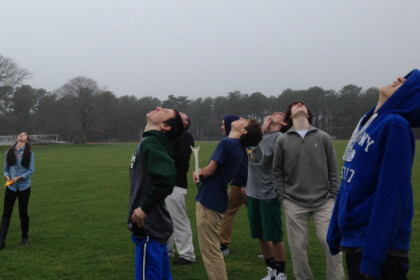
Projects & Materials

Design Squad Rocket Launch Day

“Mr. Cutler, are we launching today?”
The eighth- and ninth-grade students in Adam Cutler’s “Design Squad” class had been working for weeks toward this moment.
Even on this cloudy day, the their spirits were high as their teacher confirmed it was a launch day.
The students in this engineering-focused elective at Dennis-Yarmouth High School had only a basic understanding of force and motion when they started the project, Mr. Cutler said. But by now they had learned a strong set of science and engineering concepts and had used them to create stable rockets. Today they would test their ultimate design goal: having their rockets reach exactly the target altitudes they had planned.
The class started the process using a computer program called Open Rocket to design prototypes. Through that experience, they began to discuss the basics of physics and stability.
The next step was to interpret their rocket designs, using them to build working models they could test. At each test launch, students collected data to make modifications to their designs and revise their prototypes. Gradually, their considerations and calculations about stability, center of gravity, and center of pressure became more advanced, and they operationalized these concepts in their designs.
Watching on this launch day, it was clear that the project had been a lot of fun. But the students pointed out that the work hadn't always been easy.
It was only through trial and error that they learned, for example, that the glue holding their prototypes together was creating drag on the rockets in flight. Which sent them back to the drawing board to adjust air-flow calculations that had, on paper, seemed so right. They saw, too, how wind speed affected stability. And how sand ballast could change a rocket's center of gravity.
What a great STEM project: as the students saw their designs in action and worked out changes in their models, they were learning about more than their rockets. They were, just as engineers must, thinking critically and persevering to overcome challenges—yet it was all part of the creative process.
Out on the launching field, Mr. Cutler said, “It has been my experience that students learn and engage best when they are doing something they are excited about.” The students didn't hear him. They were busy keeping their eyes to the sky, watching, measuring, and learning as their rockets reached new heights.